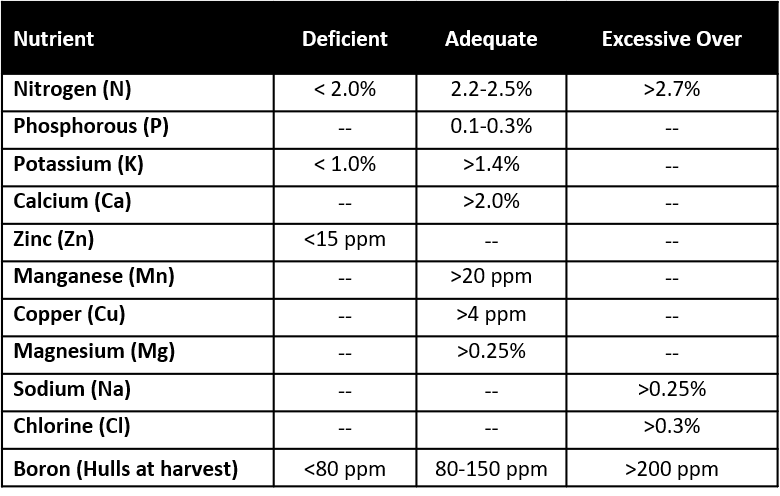Patrick H. Brown, Professor of Plant Nutrition, UC Davis
Katherine Jarvis-Shean, UCCE Orchard Advisor Yolo, Solano, & Sacramento Cos.
With prices down, growers and managers may be looking at their inputs and considering where they may be able to cut back this year. When it comes to nutrient management, there are some inputs you may be able to save, and some needs that still require attention where it’s advisable not to scrimp. Every orchard is different, but here are some questions to consider when evaluating an orchard’s nutrient management plan this year.
What nutrients are heavily drawn down and need to be attended to every year?
Every year in bearing trees a crop will be removing nitrogen and potassium from the field, roughly equivalent to 68 pounds for every 1,000 pounds of kernel yield for nitrogen and up to 80 pounds for every 1,000 pounds of kernel yield for potassium (96 lbs K20). These nutrients will have to be replaced every year if you are to maintain long-term productivity, so these are definitely not nutrients you can neglect. That said, if you have been applying nitrogen and potassium in excess of the minimum needs, there may be nitrogen or potassium reserves in your system to draw on, especially in a winter with limited leaching potential. Soil or leaf sample results (see below) can help assess if nitrogen or potassium may still be present in the soil or perennial tissue and available for uptake and use. At the very least, aim for replacement of removed nitrogen.
While there has been much talk about phosphorus in recent years, we still have not seen widespread phosphorus deficiency in California. Given the low expected price for almonds this year this might not be the best year to experiment with phosphorus.
Are there cheaper sources of nitrogen to consider this year?
If you’re looking for a cheap source of nitrogen there is none cheaper than the nitrogen that might be present in your irrigation water, so get that tested at a reputable lab and use that nitrogen to offset against any fertilizer costs.
NO3-N (mg/l, ppm) x 2.7 = lbs N per acre-foot of water
NO3 (mg/l, ppm) x 0.6 = lbs N per acre-foot of water
Nitrogen that remains in the soil from previous year’s fertilizations can also be utilized, so consider taking a soil nitrogen test to estimate how much nitrogen is in the root zone and you can save that amount of nitrogen from your fertilizer bill. The most expensive nitrogen is the nitrogen that never benefits the tree because it’s leached down out of the root zone, so manage timing and water to minimize leaching.
What are the trends in each orchard’s leaf tissue samples in recent years, and where were leaf tissue levels last year?
Consider your previous leaf tissue sample results relative to critical value thresholds (Table 1 and our July Leaf Analysis article) to see if you could stay in the adequate range with a less aggressive nutrient plan than previous years. While it’s true that almond trees certainly utilize a lot of potassium, if you’ve been doing routine tissue analysis and your 2020 tissues show that you were greater than 2% potassium you can probably save on potassium fertilization this year. In general, it takes a number of years for trees to respond to a potassium deficiency so if you’ve got to cut some corners this might be an opportunity. If, however, you’re in a very sandy soil with low residual potassium and have had very high recent yields, you still may need to replace potassium taken away from the crop in last year’s productivity.

Table 1. Critical nutrient levels for almond leaves sampled in July.
Could potassium chloride be integrated into this year’s potassium management program?
The question often arises about the potential to use potassium chloride for potassium management in almonds. Certainly it is a viable source, it is a cheap source and at least for some of the potassium demand of the crop, potassium chloride could be used. There is one caveat to this: if you have high levels of chloride in your water or soils, and it often shows in your leaf samples (table 1) then you should probably avoid potassium chloride as your potassium source. Make sure there are no soil layers that restrict leaching or a fluctuating water table that can move leached chloride back up into the root zone. If, however, your water is of good quality and chloride has not been an issue then it is quite safe to use potassium chloride for a portion of your total annual potassium demand. If you are applying potassium chloride it should be done in small amounts dissolved uniformly through the drip irrigation season if possible. Spreading potassium over a large area on heavier soils with sprinklers ties up potassium close to the surface and will reduce uptake.
What is in micronutrient blends and are they critical enough to add this year?
Micronutrients are, of course, essential for almond production; however, if you have not seen routine micronutrient deficiencies then this might be a year where you could skip the application of many of them. Two micronutrients not to skip are boron and zinc if previous leaf or hull samples showed you were on the marginal side of adequate leaf or hull levels (Table 1). As with nitrogen, consider what may be coming from your water. After this dry winter, if you’re switching to more reliance on groundwater, check to see if that will provide more boron than your usual source, and potentially offset your traditional input program.
Does the return on investment of stimulating soil microbes pencil out this year?
There is a lot of uncertainty about the use of biostimulants or microbials and it is most likely that the response to these expensive applications is rare. Given tight margins and in the absence of extensive research, this might not be a year to experiment with these products.


Leave a Reply